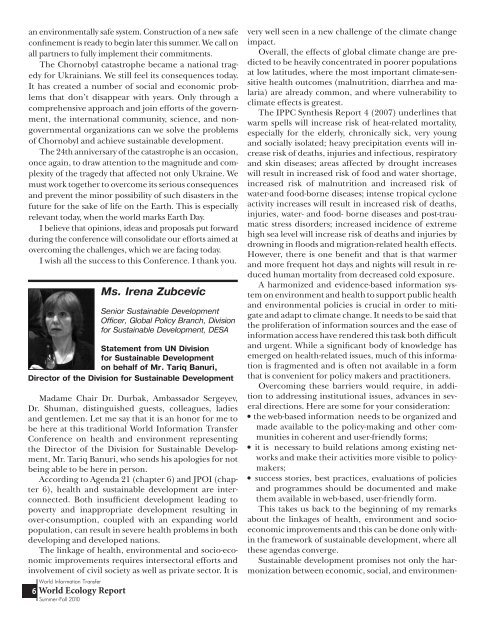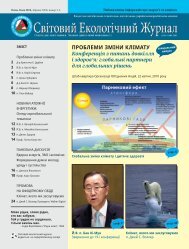V. XXII No 2, 3 - World Information Transfer
V. XXII No 2, 3 - World Information Transfer
V. XXII No 2, 3 - World Information Transfer
You also want an ePaper? Increase the reach of your titles
YUMPU automatically turns print PDFs into web optimized ePapers that Google loves.
an environmentally safe system. Construction of a new safeconfinement is ready to begin later this summer. We call onall partners to fully implement their commitments.The Chornobyl catastrophe became a national tragedyfor Ukrainians. We still feel its consequences today.It has created a number of social and economic problemsthat don’t disappear with years. Only through acomprehensive approach and join efforts of the government,the international community, science, and nongovernmentalorganizations can we solve the problemsof Chornobyl and achieve sustainable development.The 24th anniversary of the catastrophe is an occasion,once again, to draw attention to the magnitude and complexityof the tragedy that affected not only Ukraine. Wemust work together to overcome its serious consequencesand prevent the minor possibility of such disasters in thefuture for the sake of life on the Earth. This is especiallyrelevant today, when the world marks Earth Day.I believe that opinions, ideas and proposals put forwardduring the conference will consolidate our efforts aimed atovercoming the challenges, which we are facing today.I wish all the success to this Conference. I thank you.<strong>World</strong> <strong>Information</strong> <strong>Transfer</strong>6 <strong>World</strong> Ecology ReportSummer-Fall 2010Ms. Irena ZubcevicSenior Sustainable DevelopmentOfficer, Global Policy Branch, Divisionfor Sustainable Development, DESAStatement from UN Divisionfor Sustainable Developmenton behalf of Mr. Tariq Banuri,Director of the Division for Sustainable DevelopmentMadame Chair Dr. Durbak, Ambassador Sergeyev,Dr. Shuman, distinguished guests, colleagues, ladiesand gentlemen. Let me say that it is an honor for me tobe here at this traditional <strong>World</strong> <strong>Information</strong> <strong>Transfer</strong>Conference on health and environment representingthe Director of the Division for Sustainable Development,Mr. Tariq Banuri, who sends his apologies for notbeing able to be here in person.According to Agenda 21 (chapter 6) and JPOI (chapter6), health and sustainable development are interconnected.Both insufficient development leading topoverty and inappropriate development resulting inover-consumption, coupled with an expanding worldpopulation, can result in severe health problems in bothdeveloping and developed nations.The linkage of health, environmental and socio-economicimprovements requires intersectoral efforts andinvolvement of civil society as well as private sector. It isnvery well seen in a new challenge of the climate changeimpact.Overall, the effects of global climate change are predictedto be heavily concentrated in poorer populationsat low latitudes, where the most important climate-sensitivehealth outcomes (malnutrition, diarrhea and malaria)are already common, and where vulnerability toclimate effects is greatest.The IPPC Synthesis Report 4 (2007) underlines thatwarm spells will increase risk of heat-related mortality,especially for the elderly, chronically sick, very youngand socially isolated; heavy precipitation events will increaserisk of deaths, injuries and infectious, respiratoryand skin diseases; areas affected by drought increaseswill result in increased risk of food and water shortage,increased risk of malnutrition and increased risk ofwater-and food-borne diseases; intense tropical cycloneactivity increases will result in increased risk of deaths,injuries, water- and food- borne diseases and post-traumaticstress disorders; increased incidence of extremehigh sea level will increase risk of deaths and injuries bydrowning in floods and migration-related health effects.However, there is one benefit and that is that warmerand more frequent hot days and nights will result in reducedhuman mortality from decreased cold exposure.A harmonized and evidence-based information systemon environment and health to support public healthand environmental policies is crucial in order to mitigateand adapt to climate change. It needs to be said thatthe proliferation of information sources and the ease ofinformation access have rendered this task both difficultand urgent. While a significant body of knowledge hasemerged on health-related issues, much of this informationis fragmented and is often not available in a formthat is convenient for policy makers and practitioners.Overcoming these barriers would require, in additionto addressing institutional issues, advances in severaldirections. Here are some for your consideration:nthe web-based information needs to be organized andmade available to the policy-making and other communitiesin coherent and user-friendly forms;nit is necessary to build relations among existing networksand make their activities more visible to policymakers;success stories, best practices, evaluations of policiesand programmes should be documented and makethem available in web-based, user-friendly form.This takes us back to the beginning of my remarksabout the linkages of health, environment and socioeconomicimprovements and this can be done only withinthe framework of sustainable development, where allthese agendas converge.Sustainable development promises not only the harmonizationbetween economic, social, and environmen-




